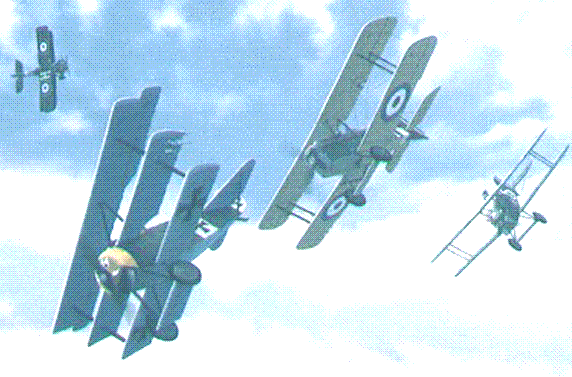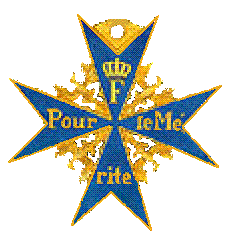
|

|

|

|
A lone silver Dreidecker stalked the evening sky. Below him, a flight of unsuspecting British fighters supporting a reconnaissance mission. Patiently he waited for just the right moment. As the mission wore on, two British SE5a's became separated. The pilot was just two kills short of his fiftieth victory. Few pilots would consider tackling two enemy aircraft alone but Werner Voss was no ordinary pilot. He liked the odds. Like a hungry leopard his Dreidecker pounced on his would be prey with deadly precision, forcing the two British SE5s to the ground.
Suddenly and without warning, the predator became the prey as seven SE5a's Dropped down upon the unsuspecting ace from nowhere. Hopelessly outnumbered it seemed like the only choices were to turn and run or fight to the bitter end.
For whatever reason Voss chose to fight. Perhaps he was unaware of the odds. Perhaps the enemy had him so well surrounded that he was unable to put the superior climbing ability of the Fokker Dreidecker to use. For what ever reason he chose to fight and he couldn't have picked a more dangerous group to fight. His opponents were not just any British pilots. This was B Flight of 56 Squadron. All seven of the pilots were aces. For the next ten minutes Voss would fly circles around his adversaries as he emptied his Spandaus and managed to pepper every enemy plane with bullet holes. In the meantime his enemy tried in vain to bring down this most noble opponent but the silver-blue triplane was simply too agile and Voss too talented a flyer for the British.
Suddenly Voss's airplane went into a shallow dive, it's propeller no longer turning. No one knows for sure why. The dreidecker had been flying for almost 90 minutes, the limit of its fuel endurance, so Voss may have run out of fuel. Or perhaps the fuel tank had been punctured and Voss was forced to shut off the engine to prevent the plane from catching fire. Perhaps, after ten minutes of fighting Voss had run out of ammunition and was attempting to surrender. Or maybe Voss had been wounded and could no longer control the plane and was attempting to surrender. No one knows for sure.
As the Dreidecker banked into the shallow turn, Voss made the fatal error of crossing the path of Arthur Rhys Davids.
Voss's Dreidecker then went into steep uncontrolled dive which Flight Leader James McCudden described as:
Arthur Rhys-Davids would fall to enemy fire himself on October 12, 1917 with 25 victories to his credit.
James McCudden would later die in a crash when his plane failed him on take off. He had 57 victories to his credit at the time.
"If I could only have brought him down alive..." Arthur Rhys-Davids to James McCudden
| Name | Survived? | Victories at time of engagement |
Total Victories |
|
|
|||
| James McCudden | Killed in flying accident 9 July 1918 |
|
|
| Gerald "Beery" Bowman | Survived died 25 March 1970 |
|
|
| Richard Mayberry | KIA 19 December 1917 |
|
|
| Keith Muspratt | Died in plane crash, 19 March 1918 |
|
|
| Arhtur Rhys-Davids | KIA 27 October 1917 |
|
|
| Reginald Hoidge | Survived Died 1 March 1963 |
|
|
| Harold Hamersley | Survived Died in December 1967 |
|
|
| Robert Chidlaw-Roberts | Survived Died 1 June 1989 |
|
|
| Cronyn | (unknown) |
|
|
|
|
|||

|
NOTE: Cronyn, Hamersley, and Chidlaw-Roberts were with 60 Squadron. Cronyn was forced down with heavy damage just as the fight got started. Hamersley and Chidlaw-Roberts would survive the Voß' attack with assistance from 56 Squadron, but only with heavy damage. The red nosed Albatros, most likely from the Jasta McCudden had spotted attempts to help Voß but arrive too late. Rhys-Davids will claim a second victory when we downs Karl Menckhoff of Jasta 3. Menckhoff survived this attack, will be shot down on two more occasions and survive the war. | ||
Damage to B Flight
Voss managed to hit every SE5 in B Flight. Some of the planes received extensive damage as described in Aces & Aeroplanes 1" "McCudden's statement that Voss 'had put some bullets through all our machines' was understating the case. The havoc that Voss had caused had been considerable.
Muspratt force-landed at No. 1 Squadron's aerodrome with a bullet in his radiator; Chidlaw-Roberts' SE was considerably shot about, although he managed to return to St Marie Cappel and Maybery's machine was hit in the upper right hand longeron and badly damaged, necessitating its return to 1AD.
Hamersley managed to land his badly damaged SE at No. 29 Squadron's aerodrome at Poperinghe. In the brief flurry of the first encounter Voss had shot through the machine's bottom left hand engine bearer, two top planes and the centre section, spars, ribs, rudder and kingpost, the water jacket on the right hand side of the engine, radiator, propeller, CC gear, generator and oil pipes, and had put 'numerous holes in the fabric'. The aeroplane was a write-off and was eventually sent to 1AD.
"Cronyn's SE5a had also been considerably damaged, and he was lucky to be able to return to his aerodrome at Estree Blanche. Cronyn later wrote to his father:
|
|
|
Aces & Aeroplanes 1 provided by Rich Hicks of the Aerodrome Forum |